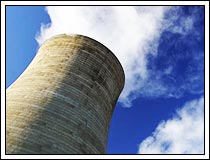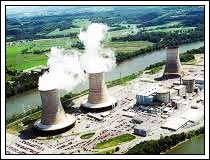Nuclear Industry
One of the most water-intensive sectors in the industrial field, the nuclear industry requires large amounts of water every day, mainly for cooling purposes. This is one reason why most nuclear-power reactors are located along coastlines or fresh water bodies. The hot-water outflows contaminated with radioactive  chemicals after being used in the process is pumped back to rivers, lakes and oceans and becomes serious threat to plants, aquatic being and humans as well. It has to be noted that radioactive wastewater comes from a number of other sources other than the nuclear industry, like medical and industrial wastes, as well as naturally occurring radioactive materials (NORM) that can be concentrated as a result of the processing or consumption of coal, oil and gas, and some minerals. chemicals after being used in the process is pumped back to rivers, lakes and oceans and becomes serious threat to plants, aquatic being and humans as well. It has to be noted that radioactive wastewater comes from a number of other sources other than the nuclear industry, like medical and industrial wastes, as well as naturally occurring radioactive materials (NORM) that can be concentrated as a result of the processing or consumption of coal, oil and gas, and some minerals.
The production of these radio active contaminants in nuclear-power plants mainly takes place during the mining and refining stage of uranium and thorium and the fission reaction involved in the production process. The majority of radio active waste possesses low levels of radio activity per mass volume and diminishes overtime if kept isolated for a period of time. However, this time limit can range from hours to years for some common medical or industrial radioactive wastes or even thousands of years for high-level wastes from nuclear power plants and nuclear weapons reprocessing. This depends mainly on the half life of the radioactive contaminant. Certain radioactive elements (such as plutonium-239) in "spent" fuel will remain hazardous to humans and other creatures for hundreds of thousands of years. Other radioisotopes remain hazardous for millions of years. On the other hand, some elements like iodine-131 has a half life of just 8 days.
Characteristic of Source Specific Radioactive Waste
Nuclear Fuel Cycle
The front end of the nuclear fuel cycle usually produces alpha-emitting waste from the extraction of uranium. It often contains radium and its decay products. The back end of the nuclear fuel cycle, mostly spent fuel rods, contains fission products that emit beta and gamma radiation, and actinides that emit alpha particles, such as uranium-234, neptunium-237, plutonium-238 and americium-241, and even sometimes some neutron emitters such as californium (Cf). Long-lived radioactive waste from the back end of the fuel cycle is especially relevant when designing a complete waste management plan for spent nuclear fuel (SNF).

Medical
Radioactive chemical waste produced by the medical sector can be segregated into two main classes - beta particle and gamma ray emitters.
Naturally Occurring Radioactive Material (NORM)
While processing substances containing "natural" radioactivity like coal, oil and gas, a lot of alpha-particle emitting waste are produced. Coal contains a small amount of radioactive uranium, barium, thorium and potassium, but, in the case of pure coal, this is significantly less than the average concentration of those elements in the Earth's crust. The wastes from the oil and gas industry mainly contains radium and its daughters.
|